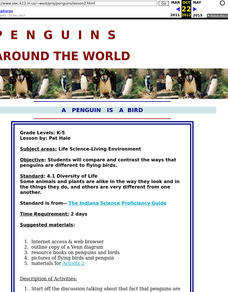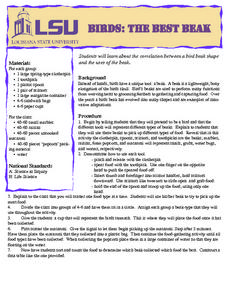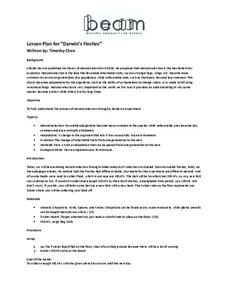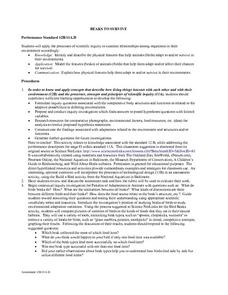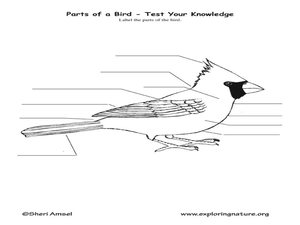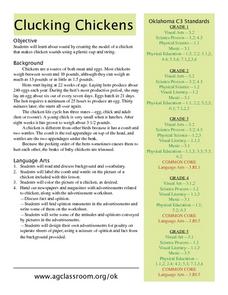Curated OER
A Penguin is a Bird
Students compare and contrast the ways that penguins are different to flying birds.
Curated OER
Birds Concept Mapping
In this biology worksheet, students complete a concept map about birds. They fill in 7 blanks with the correct terminology from the word list.
Curated OER
Birds: The Best Beak
Learners examine the correlation between a bird beak shape
and the uses of the beak.
Curated OER
Amazing Bird Adaptions--Why Am I A Bird?
Fourth graders identify and classify birds found in Illinois. Using the internet, they discover how birds have adapted over time and how the adaptations have increased their life span. They compare and contrast the various adaptations...
Curated OER
Marine & Aquatic Habitats Activities - Estuaries Are for the Birds!
Students recognize that birds act as indicators of pollution because of their sensitivity to environmental change, and role play the manner in which marine debris can be hazardous to waterfowl.
Curated OER
Birds of Wisconsin
First graders explore the job done by ornithologists. They role play identifying the characteristics that make a bird a bird. They discuss what makes each bird species unique. Students are introduced to Wisconsin's most common and rare...
Curated OER
Connect the Dots: Birds of Prey
For this science worksheet, 2nd graders will connect the dots to create an image of a bird. Students will connect the numbers from one to thirty-four.
Curated OER
Bird Word Search
In this word search worksheet, students search for a list of eight words as they relate to the topic of birds. Words can be found backward, forward, up, down, and diagonally.
Curated OER
Beans, Beaks and Bears
Students explore evolution. After watching a video on evolution, students perform a variety of experiments using beans which illustrate the concept of evolution.
Berkeley Engineering and Mentors
Darwin's Finches
Try a twist on the old finch beak and chopsticks activity by using M&Ms on a Twister mat. Spoons, knives, forks, and chopsticks represent beaks and are randomly assigned to your little birds, who must collect as much food as possible...
Curated OER
Beaks To Survive
Students discuss and identify the types of adaptations that are made by different organisms in order for them to survive. In groups, they describe the features of beaks and discuss how it affects their chances for survival. They share...
Curated OER
Watch the Birdie
Students complete a six-week unit on North American birds. They conduct research, develop fact sheets, create labeled bird drawings, write a dictionary of bird vocabulary words, create a Concentration game, and observe birds in their...
Curated OER
Science - How are Animals Grouped?
In these categorizing animals worksheets, students complete 20 true or false statements about animal groups. Students then classify the animals in the box into the correct column. Students write the letter of the correct answer for the...
Curated OER
Eeks Beaks
Seventh graders examine the concept of adaptations that take place in the wild. Birds are the focus organism for this study. They examine the beaks of different birds and point out the differentiations.
Curated OER
The Drinking Bird
Students discover how toys often illustrate fundamental physical principles. The toy drinking bird is an example. The challenge for you in the lab is to discover why the drinking bird functions.
Curated OER
Flocking to Food
Students observe shore birds feeding. In this shore birds lesson, students visit a beach and observe shore birds feeding. Students discuss shore birds feeding behaviors.
Curated OER
Learn How Baby Birds Survive
Students role play baby and mother owls. They learn how owls are fed and figure out which type of beak will work for different kinds of food. Students do this by using chopsticks, tweezers, forks and toothpicks to try and pick up...
Curated OER
Learning Bird Traits
Students draw and label a bird. In this bird traits lesson, students learn what traits make a bird different from other animals. Students are taught how to draw a bird and are expected to label the various body parts they drew.
Curated OER
Clucking Chickens
A comb, wattle, and beak are three characteristics that describe a chicken. Your class can explore the life of a chicken through reading, art, movement, and music. Using a plastic cup and string, they'll create a pretend chicken that...
Curated OER
What Kind of Animal Are You?
With the descriptions of six different animal groups (amphibians, birds, fish, insects, mammals, reptiles), students match different examples of animals to their proper groups (lizard to reptiles, girl to mammals, etc). The activity...
Curated OER
The Great Horned Owl
In this recognizing facts about the Great Horned Owl worksheet, students read fun facts, match illustrations with adaptations, sequence life cycle cards, and read what to do if they find an injured bird. Students solve 16 answers.
Curated OER
The Extinction of Dinosaurs
Students study the life and death of the dinosaur by building dioramas. In this dinosaur lesson, students research the extinct creatures, then build dinosaur dioramas. Afterward, the students engage in a discussion about the extinction...
Curated OER
Classification of Organisms
In this classification activity, students solve 3 classification riddles, complete 6 true and false questions, complete 4 sequences, and solve a riddle about the classification of an animal.
Curated OER
Toothpick Worms
Young scholars investigate camouflage. In this science lesson plan, students experience the role of color in camouflage as they complete a hands-on activity.


